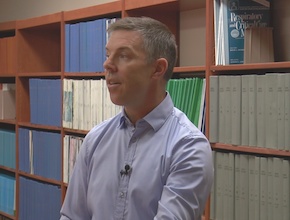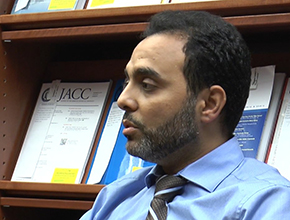References
Rhodes A, Evans LE, Alhazzani W, et al. Surviving Sepsis Campaign: International Guidelines for Management of Sepsis and Septic Shock: 2016. Crit Care Med. 2017 Jan 17. doi: 10.1097/CCM.0000000000002255. [Epub ahead of print] PubMed PMID: 28098591.PRISM Investigators. Early, Goal-Directed Therapy for Septic Shock – A Patient-Level Meta-Analysis. N Engl J Med. 2017 Mar 21. doi: 10.1056/NEJMoa1701380. [Epub ahead of print] PubMed PMID: 28320242.
This video is part of a special 6-episode series of McMaster Perspective focusing on Surviving Sepsis Campaign 2016 guidelines.
Roman Jaeschke: Good morning. Welcome to another edition of McMaster Perspective. I would like to reintroduce Doctor [Waleed] Alhazzani, who talked to us before about different aspects of sepsis. On this occasion, I am welcoming him as the methodology chair of the recently published Surviving Sepsis Campaign [guidelines]. I would like first to start by congratulating you on representing McMaster [University] and our intensive care unit in these very prestigious practice guidelines and congratulate you on your very important role in this endeavor. Maybe we will start by talking a little bit about the methodology, because in these guidelines there are strong, weak, and best-practice statements. You are probably instructing authors what it means. Maybe we can expand on this a little.
Waleed Alhazzani: Of course. Thank you, Doctor Jaeschke. It is a great pleasure to come back again and talk about Surviving Sepsis guidelines. Indeed, it is important to clarify the methodology for readers, because each terminology [item] used, especially with the strength of recommendation, has different implications clinically. We issued more than 90 recommendations in this guideline. At least 60 recommendations were split between strong or weak recommendations and probably 18 statements were best-practice statements. I will explain the difference between a strong recommendation, a weak recommendation, and a best-practice statement. Essentially, a strong recommendation implies that the desirable and undesirable consequences are clearly in favor of the intervention that is being recommended and it is probably the best option for the majority of patients; it is probably the best option that physicians should be choosing most of the time. There will be some exceptions, but before you use the alternative intervention you have to think twice “why I am using it,” it has to be justifiable.
As opposed to issuing a weak recommendation – or the other terminology is a conditional recommendation – that we will be seeing more often in future guidelines, where the desirable-undesirable consequences balance is probably in favor of the intervention, we think that it is probably the best option. However, we do not need to be dogmatic about it. As opposed to a strong recommendation, here people could still use the alternative intervention and some patients may actually choose to have the alternative intervention. So you see the difference in implications.
What is confusing for readers, clinicians especially, is that they consider a recommendation to be strong by default and they always forget to look at the strength of the recommendation and what evidence was this recommendation based on. It is important, and I hope that the way the Surviving Sepsis guidelines are written this time allows this distinction to be clear for end-users and also for researches who are planning to do future studies.
Now, the new category is the best-practice statements. They are by default strong recommendations; however, they are not linked specifically to an evidence profile. These best-practice statements should be in accordance with strict guidelines or criteria that have been published by the GRADE working group. Again, we have to be always conscious of the fact that these best-practice statements are applicable to certain conditions. I will give an example: if you have a patient with hypotension or in shock, a question could be, “Should we establish IV access for that patient?” Obviously, the answer is “yes.” Is there strong evidence to support this? No, but it is clear to us that the alternative here is implausible and probably the intervention outweighs all the downsides for not using the intervention. So it is clear that this should be a strong recommendation; however, we cannot link this to an evidence profile, for example, or a specific evidence base and allow to grade…
RJ: Other than common sense and logic.
WA: Exactly.
RJ: Okay. Well, as you noticed, about half [of the recommendations] were strong and half were weak. And the distinction is that have to think twice before you do not use strong and if somebody chooses to use an alternative in the weak recommendation, nobody should get upset.
The interesting thing about these guidelines is that they are so large and cover so many topics that I needed to have a prompt here. Why don’t we start by the first section, which was on resuscitation. Maybe you can try to summarize the big points here?WA: The resuscitation section deals specifically in the context of a patient presenting with sepsis or septic shock. We are talking about the acute phase of resuscitation. Ideally, the first thing that people should recognize – and it was highlighted clearly in this guideline – is that sepsis or septic shock is an emergency and people should act promptly. The reason for having this best-practice statement is to highlight the importance of acting fast and recognizing these cases early on.
Obviously, resuscitation involves giving fluids, giving antibiotics early, and there are few recommendations on how much fluid you should give – although this, I have to admit, was a very contentious recommendation. In this specific guideline, there is a strong recommendation for 30 mL/kg of the fluid bolus to be given in the first 3 hours when the patient arrives usually to the emergency department or is first seen in the ward or the intensive care unit (ICU) once the disease is suspected or diagnosed. The question is what is this based on. There is no clear evidence that compared 30 mL/kg with other alternatives – fluid bolus or [alternative] strategies. However, there is some indirect evidence to highlight that this is probably the common practice nowadays. If you look at the 4 large randomized controlled trials (RCTs) that compared what we call “early goal-directed therapy” or “protocolized care” versus what we call nowadays “usual care,” the way these studies were designed allowed to give a fluid bolus anywhere between 30 mL/kg, which translates to about 2 L in a 70-kg patient, or a fixed 1-L bolus in the newer studies. In reality, if you give anywhere between 1-L and 2-L fluid bolus, in my opinion that should be okay. But again, it has to do with the patients’ clinical situation – you have to examine the patients, see how they respond. Some patients will need more fluids, some will require less, obviously. It is difficult to have one size that fits all. The reason to have a specific volume is probably just to have some standardized approach and there will be always some flexibility.
RJ: I think the clinicians will appreciate the degree of flexibility which you are providing here. You mentioned 4 studies comparing usual care to protocolized care. Should we abandon protocolized care?
WA: That is a very good question. I do not think at this stage we should say we should abandon protocolized care just for the simple reason that no intervention has been shown to be superior to protocolized care and protocolized care did not show any harm compared to the usual care. The usual care that we practice nowadays is based to some extent on the major principles highlighted in the Rivers trial. However, we know that protocolized care may be associated with higher resource utilization, for example, having more oximetric catheters, more transfusions, probably use of more dobutamine. We know that you can still have similar outcomes without utilization of these interventions, but the same components – fluid resuscitation, early antibiotics, frequent assessment of your patient’s volume status – they are the same principles and they should still be implemented.
RJ: And the other component is probably having experienced physicians at the bedside.
WA: Of course.
RJ: I see here a comment about the use of ultrasound and echocardiography. Was that part of the discussion?
WA: Yes. In patients who are clearly not responding clinically or there is a suspicion of cardiogenic component, the guideline also recommends that an echocardiography at the bedside or an ultrasound be used to assess the cardiac function and explore other reasons for not responding to treatment. Again, you could think that this should be a best-practice [statement] – if you are not sure about the diagnosis and the patient’s not improving, you need to look for an alternative.
RJ: Thank you very much. That is the start of our series of Surviving Sepsis Campaign McMaster Perspectives. We will restart again in a while. Thank you.
 English
English
 Español
Español
 українська
українська











